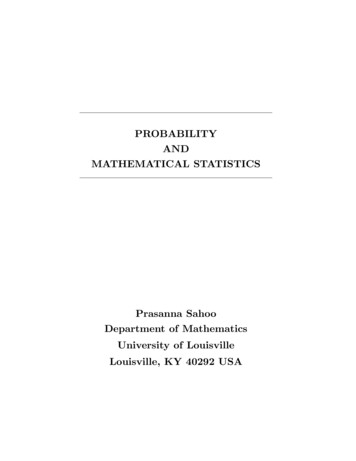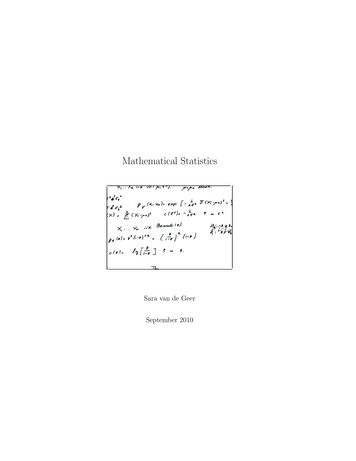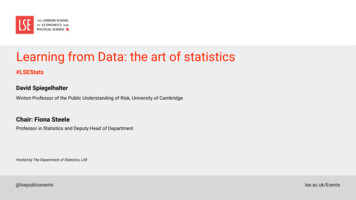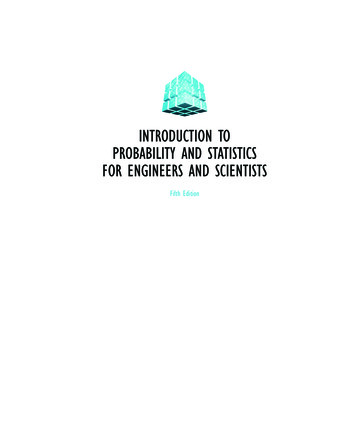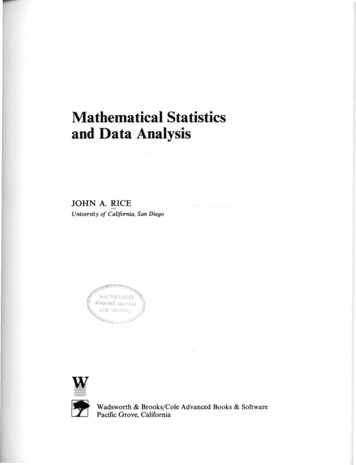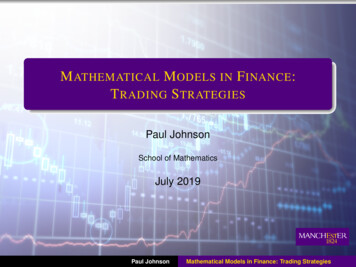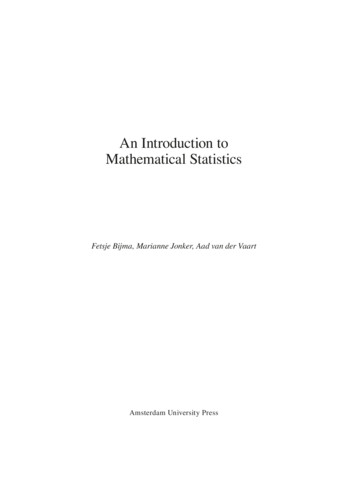
Transcription
An Introduction toMathematical StatisticsFetsje Bijma, Marianne Jonker, Aad van der VaartAmsterdam University Press
Original publication: Fetsje Bijma, Marianne Jonker, Aad van der Vaart, Inleiding in de statistiek.Epsilon Uitgaven, 2016 [ISBN 978-90-5041-135-6] Fetsje Bijma, Marianne Jonker, Aad van der Vaart, 2016Translated by: Reinie ErnéAmsterdam University Press English-language titles are distributed in the US and Canada by theUniversity of Chicago Press.isbne-isbnnurdoi978 94 6298 510 0978 90 4853 611 5 (pdf)91610.5117/9789462985100 Fetsje Bijma, Marianne Jonker, Aad van der Vaart / Amsterdam University Press B.V.,Amsterdam 2017
PREFACEThis book gives an introduction into mathematical statistics. It was written forbachelor students in (business) mathematics, econometrics, or any other subjectwith a solid mathematical component. We assume that the student already has solidknowledge of probability theory to the extent of a semester course at the same level.In Chapter 1, we give the definition and several examples of a statistical model,the foundation of every statistical procedure. Some techniques from descriptivestatistics that can assist in setting up and validating statistical models are discussedin Chapter 2. The following chapters discuss the three main topics in mathematicalstatistics: estimating, testing, and constructing confidence regions. These subjects arediscussed in Chapters 3, 4, and 5, respectively. Next, Chapter 6 provides deepertheoretical insight, in particular into the question under what circumstances and inwhat sense certain statistical models are mathematically optimal. In Chapter 7, wedescribe several regression models that are commonly used in practice. The theoryfrom the previous chapters is applied to estimate and test unknown model parametersand give confidence regions for them. Finally, in Chapter 8, we discuss modelselection. In that chapter, various criteria are presented that can be used to find thebest-fitting model from a collection of (regression) models. Sections and examplesmarked with a * are more difficult and do not belong to the basic subject matter ofmathematical statistics. Every chapter concludes with a summary.In Appendix A, we recall elements from probability theory that are relevantfor understanding the subject matter of this book. In Appendix B, we discussproperties of the multivariate normal distribution, which is used in several sections.Appendix C contains tables with values of distribution and quantile functions ofseveral distributions to which we refer in the text. These are meant to be used at homeor during problem sessions. In “real life,” these tables are no longer used: the computeris faster, more accurate, and easier to use. The statistical package R, for example,contains standard functions for the distribution function, the density function, and thequantile function of all standard distributions.The mathematical style of this book is more informal than that of manymathematics books. Theorems and lemmas are not always proved or may beformulated in an informal manner. The reason is that a pure mathematical treatment isonly possible using measure theory, of which we do not assume any knowledge. Onthe other hand, the relevance and motivation of the theorems are also clear withoutgoing into all the details.Each chapter concludes with a case study. It often contains a statistical problemthat is answered as well as possible based on the collected data, using the statisticaltechniques and methods available at that point in the book. The R-code and data ofthese applications, as well as the data of several case studies described in the book, areavailable and can be downloaded from the book’s webpage at http://www.aup.nl.Though this book includes examples, practice is indispensable to gain insight intothe subject matter. The exercises at the end of each chapter include both theoreticaland more practically oriented problems. Appendix D contains short answers to most
exercises. Solutions that consist of a proof are not included.The book has taken form over a period of 20 years. It was originally writtenin Dutch and used yearly for the course “Algemene Statistiek” (General Statistics)for (business) mathematics and econometrics students given by the mathematicsdepartment of VU University Amsterdam. The various lecturers of the coursecontributed to the book to a greater or lesser extent. One of them is Bas Kleijn. Wewant to thank him for his contribution to the appendix on probability theory. More than2000 students have studied the book. Their questions on the subject and advice on thepresentation have helped give the book its present form. They have our thanks. Thestarting point of the book was the syllabus “Algemene Statistiek” (General Statistics)of J. Oosterhoff, professor of mathematical statistics at VU University Amsterdamuntil the mid-’90s. We dedicate this book to him.In 2013, the first edition of this book was published in Dutch, and threeyears later, in 2016, the second Dutch edition came out. This second edition hasbeen translated into English, with some minor changes. We thank Reinie Erné fortranslation.Amsterdam and Leiden, March 2017
READINGReference [1] is an introduction to many aspects of statistics, somewhat comparableto An Introduction to Mathematical Statistics. References [3] and [4] are standardbooks that focus more on mathematical theory, and estimation and tests, respectively. Reference [6] describes the use of asymptotic methods in statistics, on ahigher mathematical level, and gives several proofs left out in An Introduction toMathematical Statistics. Reference [5] is a good starting point for whoever wants todelve further into the Bayesian thought process, and reference [7] provides the samefor nonparametric methods, which are mentioned in An Introduction to MathematicalStatistics but perhaps less prominently than in current practice. Reference [2]elaborates on the relevance of modeling using regression models, for example to drawcausal conclusions in economic or social sciences.[1] Davison, A.C., (2003). Statistical models. Cambridge University Press.[2] Freedman, D., (2005). Statistical models: theory and applications. CambridgeUniversity Press.[3] Lehmann, E.L. and Casella, G., (1998). Theory of point estimation. Springer.[4] Lehmann, E.L. and Romano, J.P., (2005). Testing statistical hypotheses.Springer.[5] Robert, C.P., (2001). The Bayesian choice. Springer-Verlag.[6] van der Vaart, A.W., (1998). Asymptotic statistics. Cambridge UniversityPress.[7] Wasserman, L., (2005). All of nonparametric statistics. Springer.
CONTENTS1. Introduction . . . . . . . . . . . . . . . . .1.1. What Is Statistics? . . . . . . . . . . . .1.2. Statistical Models . . . . . . . . . . . .Exercises . . . . . . . . . . . . . . . .Application: Cox Regression . . . . . . . .2. Descriptive Statistics . . . . . . . . . . . . .2.1. Introduction . . . . . . . . . . . . . . .2.2. Univariate Samples . . . . . . . . . . . .2.3. Correlation . . . . . . . . . . . . . . .2.4. Summary . . . . . . . . . . . . . . . .Exercises . . . . . . . . . . . . . . . .Application: Benford’s Law . . . . . . . .3. Estimators . . . . . . . . . . . . . . . . .3.1. Introduction . . . . . . . . . . . . . . .3.2. Mean Square Error . . . . . . . . . . . .3.3. Maximum Likelihood Estimators . . . . . .3.4. Method of Moments Estimators . . . . . . .3.5. Bayes Estimators . . . . . . . . . . . . .3.6. M-Estimators . . . . . . . . . . . . . .3.7. Summary . . . . . . . . . . . . . . . .Exercises . . . . . . . . . . . . . . . .Application: Twin Studies . . . . . . . . .4. Hypothesis Testing . . . . . . . . . . . . . .4.1. Introduction . . . . . . . . . . . . . . .4.2. Null Hypothesis and Alternative Hypothesis . .4.3. Sample Size and Critical Region . . . . . .4.4. Testing with p-Values . . . . . . . . . . .4.5. Statistical Significance . . . . . . . . . .4.6. Some Standard Tests . . . . . . . . . . .4.7. Likelihood Ratio Tests . . . . . . . . . .4.8. Score and Wald Tests . . . . . . . . . . .4.9. Multiple Testing . . . . . . . . . . . . .4.10. Summary . . . . . . . . . . . . . . . .Exercises . . . . . . . . . . . . . . . .Application: Shares According to Black–Scholes5. Confidence Regions . . . . . . . . . . . . .5.1. Introduction . . . . . . . . . . . . . . .5.2. Interpretation of a Confidence Region . . . .5.3. Pivots and Near-Pivots . . . . . . . . . .5.4. Maximum Likelihood Estimators as Near-Pivots5.5. Confidence Regions and Tests . . . . . . .5.6. Likelihood Ratio Regions . . . . . . . . 198
5.7. Bayesian Confidence Regions . . . . . . . .5.8. Summary . . . . . . . . . . . . . . . .Exercises . . . . . . . . . . . . . . . .Application: The Salk Vaccine . . . . . . .6. Optimality Theory . . . . . . . . . . . . . .6.1. Introduction . . . . . . . . . . . . . . .6.2. Sufficient Statistics . . . . . . . . . . . .6.3. Estimation Theory . . . . . . . . . . . .6.4. Testing Theory . . . . . . . . . . . . .6.5. Summary . . . . . . . . . . . . . . . .Exercises . . . . . . . . . . . . . . . .Application: High Water in Limburg . . . . .7. Regression Models . . . . . . . . . . . . . .7.1. Introduction . . . . . . . . . . . . . . .7.2. Linear Regression . . . . . . . . . . . .7.3. Analysis of Variance . . . . . . . . . . .7.4. Nonlinear and Nonparametric Regression . . .7.5. Classification . . . . . . . . . . . . . .7.6. Cox Regression Model . . . . . . . . . .7.7. Mixed Models . . . . . . . . . . . . . .7.8. Summary . . . . . . . . . . . . . . . .Exercises . . . . . . . . . . . . . . . .Application: Regression Models and Causality .8. Model Selection . . . . . . . . . . . . . . .8.1. Introduction . . . . . . . . . . . . . . .8.2. Goal of Model Selection . . . . . . . . . .8.3. Test Methods . . . . . . . . . . . . . .8.4. Penalty Methods . . . . . . . . . . . . .8.5. Bayesian Model Selection . . . . . . . . .8.6. Cross-Validation . . . . . . . . . . . . .8.7. Post-Model Selection Analysis . . . . . . .8.8. Summary . . . . . . . . . . . . . . . .Application: Air Pollution . . . . . . . . .A. Probability Theory . . . . . . . . . . . . . .A.1. Introduction . . . . . . . . . . . . . . .A.2. Distributions . . . . . . . . . . . . . .A.3. Expectation and Variance . . . . . . . . .A.4. Standard Distributions . . . . . . . . . .A.5. Multivariate and Marginal Distributions . . . .A.6. Independence and Conditioning . . . . . . .A.7. Limit Theorems and the Normal ApproximationExercises . . . . . . . . . . . . . . . .B. Multivariate Normal Distribution . . . . . . . .B.1. Introduction . . . . . . . . . . . . . . 329329329332333338339342345347347
B.2. Covariance Matrices . . . . . .B.3. Definition and Basic Properties . .B.4. Conditional Distributions . . . .B.5. Multivariate Central Limit TheoremB.6. Derived Distributions . . . . . .C. Tables . . . . . . . . . . . . . .C.1. Normal Distribution . . . . . .C.2. t-Distribution . . . . . . . . .C.3. Chi-Square Distribution . . . . .C.4. Binomial Distribution (n 10) . .D. Answers to Exercises . . . . . . . .Index . . . . . . . . . . . . . .347348352353353355356357358360362369
1 Introduction1.1 What Is Statistics?Statistics is the art of modeling (describing mathematically) situations in whichprobability plays a role and drawing conclusions based on data observed in suchsituations.Here are some typical research questions that can be answered using statistics:(i) What is the probability that the river the Meuse will overflow its banks this year?(ii) Is the new medical treatment significantly better than the old one?(iii) What is the margin of uncertainty in the prediction of the number of representatives for political party A?Answering such questions is not easy. The three questions above correspond to thethree basic concepts in mathematical statistics: estimation, testing, and confidenceregions, which we will deal with extensively in this book. Mathematical statisticsdevelops and studies methods for analyzing observations based on probability models,with the aim to answer research questions as above. We discuss a few moreexamples of research questions, observed data, and corresponding statistical modelsin Section 1.2.In contrast to mathematical statistics, descriptive statistics is concerned withsummarizing data in an insightful manner by averaging, tabulating, making graphicalrepresentations, and processing them in other ways. Descriptive methods are onlydiscussed briefly in this book, as are methods for collecting data and the modelingof data.1
1: Introduction1.2 Statistical ModelsIn a sense, the direction of statistics is precisely the opposite of that of probabilitytheory. In probability theory, we use a given probability distribution to compute theprobabilities of certain events. In contrast, in statistics, we observe the results ofan experiment, but the underlying probability distribution is (partly) unknown andmust be derived from the results. Of course, the experimental situation is not entirelyunknown. All known information is used to construct the best possible statisticalmodel. A formal definition of a “statistical model” is as follows.Definition 1.1 Statistical modelA statistical model is a collection of probability distribution on a given sample space.The interpretation of a statistical model is: the collection of all possibleprobability distributions of the observation X. Usually, this observation is made upof “subobservations,” and X (X1 , . . . , Xn ) is a random vector. When the variablesX1 , . . . , Xn correspond to independent replicates of the same experiment, we speakof a sample. The variables X1 , . . ., Xn are then independent, identically distributed,and their joint distribution is entirely determined by the marginal distribution, whichis the same for all Xi . In that case, the statistical model for X (X1 , . . ., Xn ) can bedescribed by a collection of (marginal) probability densities for the subobservationsX 1 , . . . , Xn .The concept of “statistical model” only truly becomes clear through examples. Assimply as the mathematical notion of “statistical model” is expressed in the definitionabove, so complicated is the process of the statistical modeling of a given practicalsituation. The result of a statistical study depends on the construction of a good model.Example 1.2 SampleIn a large population consisting of N persons, a proportion p has a certaincharacteristic A; we want to “estimate” this proportion p. It is too much work toexamine everyone in the population for characteristic A. Instead, we randomly choosen persons from the population, with replacement. We observe (a realization of) therandom variables X1 , . . ., Xn , whereXi 0 if the ith person does not have A,1 if the ith person has A.Because of the set-up of the experiment (sampling with replacement), we knowbeforehand that X1 , . . . , Xn are independent and Bernoulli-distributed. The lattermeans thatP(Xi 1) 1 P(Xi 0) p2
1.2: Statistical Modelsfor i 1, . . ., n. There is no prior knowledge concerning the parameter p, other then0 p 1. The observation is the vector X (X1 , . . . , Xn ). The statistical modelfor X consists of all possible (joint) probability distributions of X whose coordinatesX1 , . . . , Xn are independent and have a Bernoulli distribution. For every possiblevalue of p, the statistical model contains exactly one probability distribution for X.It seems natural to “estimate”nthe unknown p by the proportion of the personswith property A, that is, by n 1 i 1 xi , where xi is equal to 1 or 0 according towhether the person has property A or not. In Chapter 3, we give a more precisedefinition of “estimating.” In Chapter 5, we use the model we just described toquantify the difference between this estimator and p, using a “confidence region.” Thepopulation and sample proportions will almost never be exactly equal. A confidenceregion gives a precise meaning to the “margin of errors” that is often mentioned withthe results of an opinion poll. We will also determine how large that margin is whenwe, for example, study 1000 persons from a population, a common number in pollsunder the Dutch population.Example 1.3 Measurement errorsIf a physicist uses an experiment to determine the value of a constant μ repeatedly, hewill not always find the same value. See, for example, Figure 1.1, which shows the23 determinations of the speed of light by Michelson in 1882. The question is howto “estimate” the unknown constant μ from the observations, a sequence of numbersx1 , . . . , xn . For the observations in Figure 1.1, this estimate will lie in the range 700–900, but we do not know where. A statistical model provides support for answeringthis question. Probability models were first applied in this context at the end of the18th century, and the normal distribution was “discovered” by Gauss around 1810 forthe exact purpose of obtaining insight into the situation described here.6007008009001000Figure 1.1. The results of the 23 measurements of the speed of light by Michelson in 1882.Thescale along the horizontal axis gives the measured speed of light (in km/s) minus 299000 km/s.3
1: IntroductionIf the measurements are all carried out under the same circumstances, independently of the past, then it is reasonable to include in the model that these numbersare realizations of independent, identically distributed random variables X1 , . . . , Xn .The measurement errors ei Xi μ are then also random variables. A commonassumption is that the expected measurement error is equal to 0, in other words, Eei 0, in which case EXi E(ei μ) μ. Since we have assumed that X1 , . . . , Xnare independent random variables and all have the same probability distribution, themodel for X (X1 , . . . , Xn ) is fixed by the choice of a statistical model for Xi .For Xi , we propose the following model: all probability distributions with finiteexpectation μ. The statistical model for X is then: all possible probability distributionsof X (X1 , . . . , Xn ) such that the coordinates X1 , . . . , Xn are independent andidentically distributed with expectation μ.Physicists often believe that they have more prior information and make moreassumptions on the model. For example, they assume that the measurement errorsare normally distributed with expectation 0 and variance σ 2 , in other words, that theobservations X1 , . . . , Xn are normally distributed with expectation μ and variance σ 2 .The statistical model is then: all probability distributions of X (X1 , . . . , Xn ) suchthat the coordinates are independent and N (μ, σ 2 )-distributed.The final goal is to say something about μ. In the second model, we know more,so we should be able to say something about μ with more “certainty.” On the otherhand, there is a higher “probability” that the second model is incorrect, in which casethe gain in certainty is an illusory one. In practice, measurement errors are often, butnot always, approximately normally distributed. Such normality can be justified usingthe central limit theorem (see Theorem A.28) if a measurement error can be viewedas the sum of a large number of small independent measurement errors (with finitevariances), but cannot be proved theoretically. In Chapter 2, we discuss methods tostudy normality on the data itself.The importance of a precisely described model is, among other things, thatit allows us to determine what is a meaningful way to “estimate” μ from theobservations. An obvious choice is to take the average of x1 , . . . , xn . In Chapter 6,we will see that this is the best choice (according to a particular criterion) if themeasurement errors indeed have a normal distribution with expectation 0. If, on theother hand, the measurement errors are Cauchy-distributed, then takingthe averagenis disastrous. This can be seen in Figure 1.2. It shows the average n 1 i 1 xi , forn 1, 2, . . . , 1000, of the first n realizations x1 , . . . , x1000 of a sample from astandard Cauchy distribution. The behavior of the averages is very chaotic, and theydo not convergeto 0. This can be explained by the remarkable theoretic result that theaverage n 1 ni 1 Xi of independent standard Cauchy-distributed random variablesX1 , . . . , Xn also has a standard Cauchy distribution. So taking the averages changesnothing!Example 1.4 Poisson stocksA certain product is sold in numbers that vary for different retailers and fluctuate overtime. To estimate the total number of items needed, the central distribution center4
505101520251.2: Statistical Models02004006008001000Figure 1.2. Cumulative averages (vertical axis) of n 1, 2, . . . , 1000 (horizontal axis) realizationsfrom the standard Cauchy distribution.registers the total number of items sold per week and retailer for several weeks. Theyobserve x (x1,1 , x1,2 , . . . , xI,J ), where xi,j is the number of items sold by retailer iin week j. The observation is therefore a vector of length the product IJ of the numberof retailers and the number of weeks, with integral coordinates. The observations canbe seen as realizations of the random vector X (X1,1 , X1,2 , . . . , XI,J ). Manydifferent statistical models for X are possible and meaningful in given situations. Acommon (because often reasonably fitting) model states:- Every Xi,j is Poisson-distributed with unknown parameter μi,j .- The X1,1 , . . ., XI,J are independent.This fixes the probability distribution of X up to the expectations μi,j EXi,j . Itis these expectations that the distributioncenter is interested in. The total expecteddemandinweekj,forexample,isμ.i i,j Using the Poisson-character of the demandX,thedistributioncentercanchoose a stock size that gives a certain (high)i,jiprobability that there is sufficient stock.The goal of the statistical analysis is to deduce μi,j from the data. Up to now, wehave left the μi,j completely “free.” This makes it difficult to estimate them from thedata, because only one observation, xi,j , is available for each μi,j . It seems reasonableto reduce the statistical model by including prior assumptions on μi,j . We could, forexample, postulate that μi,j μi does not depend on j. The expected number ofitems sold then depends on the retailer but is constant over time. We are then leftwith I unknowns, which can be “estimated” reasonable well from the data providedthat the number of weeks J is sufficiently large. More flexible, alternative models areμi,j μi βi j and μi,j μi βμi j, with, respectively, 2I and I 1 parameters. Bothmodels correspond to a linear dependence of the expected demand on time.Example 1.5 RegressionTall parents in general have tall children, and short parents, short children. The heightsof the parents have a high predictive value for the final (adult) length of their children,their heights once they stop growing. More factors influence it. The gender of the5
1: Introductionchild, of course, plays an important role. Environmental factors such as healthy eatinghabits and hygiene are also important. Through improved nutrition and increasedhygiene in the past 150 years, factors that hinder growth like infectious diseases andmalnutrition have decreased in most Western countries. Consequently, the averageheight has increased, and each generation of children is taller.The target height of a child is the height that can be expected based on the heightsof the parents, the gender of the child, and the increase of height over generations. Thequestion is how the target height depends on these factors.Let Y be the height a child will reach, let x1 and x2 be the heights of thebiological father and mother, respectively, and let x3 be an indicator for the gender(x3 1 for a girl and x3 1 for a boy). The target height EY is modeled using aso-called linear regression modelEY β0 β1 x1 β2 x2 β3 x3 ,where β0 is the increase in average height per generation, β1 and β2 are the extent towhich the heights of the parents influence the target height of their offspring, and β3is the deviation of the target height from the average final height that is caused by thegender of the child. Since men are, on average, taller than women, β3 will be positive.The model described above does not say anything about individual heights, onlyabout the heights of the offspring of parents of a certain height. Two brothers have thesame target height, since they have the same biological parents, the same gender, andbelong to the same generation. The actual final height Y can be described asY β0 β1 x1 β2 x2 β3 x3 e,where e Y EY is the deviation of the actual final height Y from the target heightEY . The observation Y is also called the dependent variable, and the variables x1 , x2 ,and x3 the independent or predictor variables. The deviation e is commonly assumedto have a normal distribution with expectation 0 and unknown variance σ2 . The finalheight Y then has a normal distribution with expectation β0 β1 x1 β2 x2 β3 x3and variance σ 2 .In the Netherlands, the increase in the height of youth is periodically recorded.In 1997, the Fourth National Growth Study took place. Part of the study was todetermine the correlation between the final height of the children and the heightsof their parents. To determine this correlation, data were collected on adolescentsand their parents. This resulted in the following observations: (y1 , x1,1 , x1,2 , x1,3 ),. . . , (yn , xn,1 , xn,2 , xn,3 ), where yi is the height of the ith adolescent, xi,1 and xi,2are the heights of the biological parents, and xi,3 is an indicator for the gender ofthe ith adolescent. Suppose that the observations are independent replicates of linearregression model given above; in other words, given xi,1 , xi,2 , and xi,3 , the variableYi has expectation β0 β1 xi,1 β2 xi,2 β3 xi,3 and variance σ 2 . The parameters(β0 , β1 , β2 , β3 ) are unknown and can be estimated from the observations. For a simpleinterpretation of the model, we choose β1 β2 1/2, so that the target height isequal to the average height of the parents corrected for the gender of the child and theinfluence of time. The parameters β0 and β3 are equal to the increase in height in the6
1.2: Statistical Modelsprevious generation and half the average height difference between men and women.These parameters are estimated using the least-squares method (see Example 3.44).The parameter β0 is estimated to be 4.5 centimeters, and β3 is estimated to be 6.5centimeters.† The estimated regression model is then equal to1Y 4.5 (x1 x2 ) 6.5x3 e.2Figure 1.3 shows the heights of 44 young men (on the left) and 67 young women(on the right) set out against the average heights of their parents.‡ The line is theestimated regression line found in the Fourth National Growth 165170175180185165170175180185Figure 1.3. Heights (in cm) of sons (left) and daughters (right) set out against the average heightof their parents. The line is the regression line found in the Fourth National Growth Study.We can use the estimated regression model found in the Fourth National GrowthStudy to predict the final heights of children born now. We must then assume that theheight increase in the next generation is again 4.5 centimeters and that the averageheight difference between men and women remains 13 centimeters. Based on themodel presented above, the target heights of sons and daughters of a man of height 180cm ( 71 in or 5’9”) and a woman of height 172 cm are 4.5 (180 172)/2 6.5 187 cm and 4.5 (180 172)/2 6.5 174 cm, respectively.Other European countries use other models. In Switzerland, for example, thetarget height isx1 x2EY 51.1 0.718 6.5x3 .2†An inch is approximately 2.54 cm, so 4.5 cm corresponds to 4.5/2.54 1.8 in and 6.5 cm 2.6 in.‡Source: The data were gathered by the department of Biological Psychology of VU UniversityAmsterdam during a study on health, lifestyle, and personality. The data can be found on the book’swebpage at http://www.aup.nl under heightdata.7
1: IntroductionThe target heights of sons and daughters of parents of the same heights as above arenow 184 and 171 centimeters, respectively.In the example above, there is a linear correlation between the response Y and theunknown parameters β0 , . . ., β3 . In that case, we speak of a linear regression model.The simplest linear regression model is that where there is only one predictor variable:Y β0 β1 x e;this is called a simple linear regression model (in contrast to the multiple linearregression model when there are more predictor variables).In general, we speak of a regression model when there is a specific correlationbetween the response Y and the observations x1 , . . ., xp :Y fθ (x1 , . . ., xp ) e,where fθ describes the correlation between the observations x1 , . . ., xp and theresponse Y , and
starting point of the book was the syllabus “Algemene Statistiek” (General Statistics) of J. Oosterhoff, professor of mathematical statistics at VU University Amsterdam until the mid-’90s.We dedicate this

